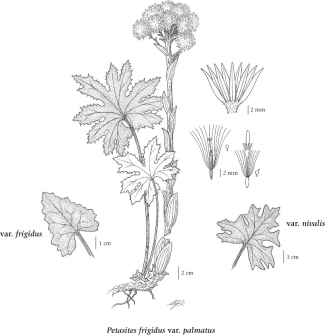Petasites frigidus var. palmatus (L.) Fr. (Aiton) Cronquist
sweet coltsfoot (arctic sweet coltsfoot; palmate coltsfoot)
Asteraceae (Aster family)
Introduction to Vascular Plants
sweet coltsfoot (arctic sweet coltsfoot; palmate coltsfoot)
Asteraceae (Aster family)
Introduction to Vascular Plants
Map
Distribution of Petasites frigidus var. palmatus
Click here to view the full interactive map and legend
Species Information
General:
Perennial herb from a creeping root; stems erect, branched above, numerous, more or less white woolly-hairy, with parallel-veined bracts 2.5-6 cm long, reduced upwards, 5-50 cm tall, flowering stems appear before the leaves.
Leaves:
Basal leaves arising directly from the creeping root, triangular to heart-shaped on long stalks, shallowly to palmately lobed or toothed, white-woolly to nearly glabrous beneath, green and somewhat hairy above, 4-50 cm long; stem leaves alternate, reduced, represented by parallel-veined bracts 1-6 cm long, more or less white woolly-hairy.
Flowers:
Heads disciform or with ray and disk flowers, several to many in a round- to flat-topped inflorescence, stalks glandular and white-woolly; involucres 6-15 mm tall; involucral bracts oblanceolate to lanceolate, pointed, hairy basally with multicellular hairs, the crosswalls often purple, margins translucent, tips fine-hairy; ray flowers few, whitish or pinkish; disk flowers whitish.
Fruits:
Achenes 5-10-ribbed, glabrous, rarely sparsely long-hairy, 3-4.5 mm; pappus of numerous white, hairlike bristles.
Notes:
Three varieties occur in BC.
1. Leaves merely coarsely toothed or shallowly and obscurely lobed; plants of the subalpine and alpine zones........................ var. frigidus
1. Leaves conspicuously lobed; plants of the lowland to alpine zones.
2. Leaves palmately lobed and usually deeply cleft more than 1/2 way to the leaf base, usually broader than long; plants of the lowland and montane zones........................... var. palmatus (Ait.) Cronq.
2. Leaves lobed, sometimes palmately, but usually not cleft more than 1/2 way to the leaf base, usually longer than broad; plants of the subalpine and alpine zones...................... var. nivalis (Greene) Cronq.
Illustration

If more than one illustration is available for a species (e.g., separate illustrations were provided for two subspecies) then links to the separate images will be provided below. Note that individual subspecies or varietal illustrations are not always available.
Illustration Source: The Illustrated Flora of British Columbia
Ecology
Ecological Framework for Petasites frigidus var. palmatus
The table below shows the species-specific information calculated from
original data (BEC database) provided by the BC Ministry of Forests and Range.
(Updated August, 2013)
The table below shows the species-specific information calculated from
original data (BEC database) provided by the BC Ministry of Forests and Range.
(Updated August, 2013)
| Site Information |
Value / Class |
||
|
Avg |
Min |
Max |
|
| Elevation
(metres) |
969 | 5 | 2500 |
| Slope
Gradient (%) |
8 | 0 | 205 |
|
Aspect (degrees) |
355 | 0 | 360 |
| Soil
Moisture Regime (SMR) [0 - very xeric; 4 - mesic; 8 - hydric] |
4 | 1 | 8 |
| Modal
Nutrient Regime
Class |
C | ||
| #
of field plots species was recorded in: |
3259 | ||
| Modal
BEC Zone Class |
SBS | ||
|
All BEC Zones (# of stations/zone) species was recorded in |
BAFA(2), BWBS(670), CDF(1), CWH(21), ESSF(301), ICH(275), IDF(117), MH(1), MS(259), PP(1), SBPS(191), SBS(1144), SWB(50) | ||
|
Source:
Klinkenberg 2013
|
|||
Habitat and Range
Wet to moist ditches, streambanks, meadows and forests in the lowland to alpine zones; var. palmatus is common throughout all BC except the Queen Charlotte Islands and adjacent coast, var. nivalis is common throughout BC, and var. frigidus is frequent in extreme N BC and rare southward; var. palmatus - E to NF and S to MA, MI and CA; var. nivalis - E to PQ and N MN and S to N OR, and var. frigidus - circumboreal, N to AK, YT and NT, Eurasia.Status Information
| Scientific Name | Origin Status | Provincial Status | BC List (Red Blue List) | COSEWIC |
|---|---|---|---|---|
| Petasites frigidus var. frigidus | Native | S5 | Yellow | Not Listed |
| Petasites frigidus var. nivalis | Native | S5 | Yellow | Not Listed |
| Petasites frigidus var. palmatus | Native | S5 | Yellow | Not Listed |
| Petasites frigidus var. sagittatus | Native | S5 | Yellow | Not Listed |
| Petasites frigidus var. x vitifolius | Native | SNA | No Status | Not Listed |
BC Ministry of Environment: BC Species and Ecosystems Explorer.
Synonyms
Synonyms and Alternate Names:
Nardosmia arctica (A.E. Porsild) A. Löve & D. Löve
Petasites arcticus A.E. Porsild
Petasites frigidus subsp. arcticus (A.E. Porsild) Cody
Petasites frigidus subsp. palmatus (Aiton) Cody
Petasites hookerianus (Nutt.) Rydb.
Petasites palmatus (Aiton) A. Gray
Petasites speciosus (Nutt.) Piper